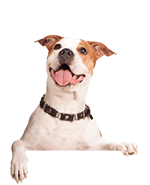There are the pullers.
There are the laggers.
There are the dogs who bark at any and every moving object in sight.
The list goes on…
Behavioral issues in dogs can have a huge impact on your daily activities and your time spent together in general.
If it seems like you and your pup are always walking to the beat of different drums, don’t worry! We’re here to share several tips and tricks you can start using right away to make walks with your fur baby more enjoyable.
Always Make Sure You Have The Right Equipment
Proper leash training begins with having the right equipment. It’s possible that your dog doesn’t have behavioral issues, but may in fact just be wearing the wrong harness, leash, or collar.
Below, you can learn more about some of the common types of dog equipment and their purposes. Then, the next time you head to your local pet store, you won’t feel so intimidated by the seemingly endless options available for purchase in the dog walking aisle.
Dog Harnesses
Harnesses are a great choice for dogs who tend to pull on their leash. A back clip harness is a good option for dogs who have already learned how to walk on a leash but need a bit of extra guidance, as it attaches to the leash at the back of the dog’s body. A front clip harness, on the other hand, is designed for dogs who are still learning to walk on a leash, as it attaches to the leash at the front of the dog’s body and encourages them to walk beside you rather than pulling.
A dual-clip harness combines both front and back attachments, providing more versatility for different situations. A gentle leader is another type of harness that’s designed to reduce pulling by gently redirecting the dog’s head and body.
Dog Leashes
When it comes to leashes, a front lead leash is a good choice for dogs who tend to pull, as it attaches to the front of the harness and helps to redirect their attention towards their owner. A retractable leash allows for more freedom and range of motion, but should only be used in safe areas and with dogs who have good leash manners.
If you venture out for dog walking in Columbus, Ohio pretty often, you would LOVE the shoulder strap and waist leashes. They are super effective for hands-free walking, as they allow you to keep your hands free while still maintaining control over the dog you’re walking. Additionally, the leash is strapped around your body – so no more worrying about any leash reactive pups escaping your grip! Always make sure the leash is attached to a secure harness or collar to prevent the dog from running off.
Once you’ve got the perfect leash for your pup, you can complete it with a leash coupler. Leash couplers are designed to allow you to walk two dogs on a single leash, making it easier to manage multiple dogs at once. They come in different designs, such as a Y-shape or a splitter, and can be attached to a single leash. Leash couplers are ideal for dogs that are well-behaved and walk nicely together, but may not be suitable for dogs with different walking paces or behaviors. Many have bungee-like qualities to them, however, so should your pup pull any, the coupler can act as a good shock absorber to the pull.
Dog Collars
There are also several types of collars available, including flat collars, martingale collars, and slip collars. Flat collars are the most common and are suitable for most dogs, while martingale collars are designed for dogs with narrow heads who may slip out of a regular collar. Slip collars, also known as choke chains, should only be used under the guidance of a professional trainer and are not recommended for most dogs.
In summary, having the right equipment and knowledge is crucial when it comes to leash training your dog. By understanding the different types of collars, harnesses, and leashes available, you’ll be better equipped to choose the right gear for your dog’s specific needs. And with that knowledge, the seemingly endless options available for purchase in the dog walking aisle at your local pet store won’t feel so intimidating.
Similarly, having proper knowledge of the different collars, harnesses and leashes is a dog-parent MUST when it comes to the topic of leash training.
Plus, once you’ve got a grip on at least the very basics, the endless options available for purchase in the dog walking aisle at your local pet store won’t feel so intimidating.
When In Doubt, Contact A Local Dog Trainer!
We know that walking your dog can be stressful sometimes, especially if you have a dog that walks YOU when it should be the other way around! That’s why it’s important that you’re using the appropriate equipment to combat your struggles, reward good behavior, and consistently encourage your pup to do and be his/her best!
If you feel like you’ve tried everything and still have a lack of control over your fur baby, it could be in you and your pup’s best interest to hire a professional dog trainer. A professional can definitely be a great resource in guiding you through obedience issues, agility training, and anything else you may need help with. At the end of the day, their goal is to enrich the bond between you and your fur baby.
We hope that our tips and techniques help you out! If they do, make sure to tell us about it in the comments below!














